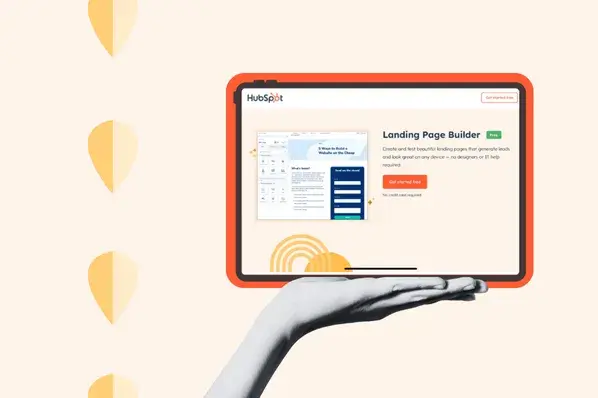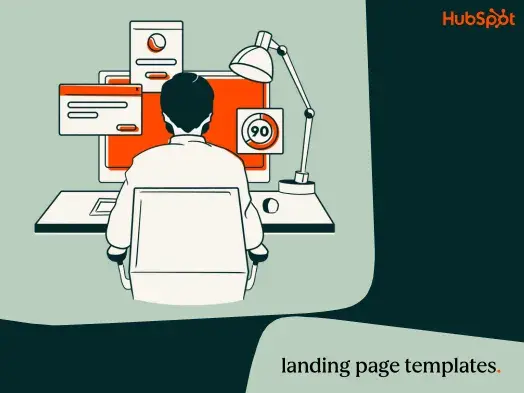Myth #1: You only need a few of them.
Lots of people think that you don't need many landing pages. Maybe you have a 'Contact Us' page and a demo page, and that's pretty much it, right? Wrong. If you only have a few landing pages, you're missing out on traffic, leads, and customers big time.
Every new landing page you create is another opportunity for you to appear in search engines and get your link shared on social media -- and better search engine rankings and social media posts mean that you'll have more opportunity to drive traffic and conversions for your website.
Additionally, besides landing pages on your website, you're going to need landing pages to convert leads. These pages are probably not available on search engines, but will help you track how many leads have clicked into an offer and how many have downloaded your content offers.
Need more convincing about the importance of having more landing pages? Check out this post.
Myth #2:Short forms are better than long forms.
No form length is the "best" -- it all depends on what you're trying to accomplish with the form. Are you trying to get a ton of new leads? Keep the form short. Are you trying to get really qualified leads? Make the form longer. One is not better than the other -- they just address different goals.
Your form length will most likely end up somewhere in the middle. To find your form length sweet spot, run A/B tests and adjust your form length according to their results.
Myth #3:If I copy someone else's landing page, my conversion rates will go up.
Landing page examples and templates are great jumping off points for your own landing pages, but you shouldn't expect to plug your content into someone else's landing page and end up raking in the conversions. A landing page is successful because of interaction of many nuanced elements -- the content on the page, the design of the page, and the audience viewing the page.
If you're going to copy a landing page layout, use best practices to tweak it to helpyour audience convert on your offer, then test it and test it to make it better.
Ultimately, a landing page will only succeed if the content offer matches the intent of the customer.
Myth #4:You need to have all conversion elements above the fold.
Lots of people believe that all of the important content on your landing page should appear above the fold -- supposedly, people won't scroll to fill out the form or find out more crucial information about what lies behind the form.
But the fold doesn't really affect conversion -- KISSmetrics found that when people are motivated to convert on a page, they do, regardless of where the form submit button is. According to that article, the biggest factor in increasing motivation is compelling copy, regardless of length. So forget optimizing only for the fold -- through A/B testing, figure out how much information people need to convert.
Myth #5: Trust seals always increase conversions.
Think about the situations in which you often see trust seals. You're usually giving over your credit card number or some other sensitive contact information, right? It makes sense to get a little visual reminder that your information is safe, because you really are giving over sensitive information.
But what if you saw a trust seal on a page where you weren't giving over sensitive information? It'd be out-of-place, making you wonder what the heck the company was really collecting from you, right? Trust elements can help tremendously on pages that need them -- but they can also deter folks if they're included on pages that don't.
Myth #6: If you change your form button from green to red, you'll increase conversions.
Full disclosure: we've run this test and found that a red call-to-action (CTA) outperformed a green CTA ... but that doesn't mean that red buttons are always better than green ones. That test worked for that page, with that page's design, for that page's audience. If you run the same test on your site, you might find that the opposite is true.
This myth goes for any color test really --there is no one right color that'll convert tons and tons more people. Test out colors yourself to see what works best.
Myth #7: Landing page copy should always be short and sweet.
Like color, there's no right length of landing page copy. We kind of touched on this in Myth #4, but the copy length myth is perpetuated enough it deserved a section of its own.
Landing page copy length is like what your teachers would say when you'd ask them how long an essay should be -- however long it needs to be to cover the subject. In the case of landing pages, it should be however long you need it to be to have people convert on your landing page's form. For complex offers that require people ponying up a lot of money or their sensitive information, more information could be better. For simple offers, like an ebook, you probably don't need a ton of landing page copy.
Like almost all of these myths, this one's nuanced. Run tests on your landing pages to find out what copy length your visitors need.
Myth #8: Conversion rate is the only metric to watch.
Landing pages are a stepping stone in your marketing funnel. You're not just trying to get people to fill out a form. You'd hope that eventually they'll become a customer from you.
So if you're trying to get the most out of your landing pages, you shouldn't just look at the percent of people who converted on that form -- you want to look and see what happens after.
What percentage of them become customers? By looking at your closed-loop analytics, you may find that a landing page that has a low initial conversion rate actually brings in customers like crazy, or vice versa ... which is something your boss would care to know and fix.
Myth #9: You should include as many things as possible on your landing page to get people to convert on something.
Your landing page isn't a last-ditch effort to capture someone's information. It's there to get people to convert on your form and move down your marketing funnel. You don't want to give people too many options because they'll get distracted and your conversion rate goes down. This means you should try removing your navigation and any extraneous forms. More is not better when it comes to landing page elements.
Myth #10: You build 'em and leave 'em.
You could probably guess this last myth from one piece of advice I've repeated over and over throughout this post: Test your landing pages. There are almost always ways you can tweak and improve them. If you build them and leave them alone, you're losing out on valuable conversions. Landing pages support the backbone of your marketing funnel -- so make sure you're getting the most you can out of them by running A/B tests often.
Building a landing page can feel like a daunting task with the contradictory advice out there. That's why you should use a landing page builder to assist you.
Editor's note: This post was originally published in March 2014 and has been updated for comprehensiveness.









![Why You Need to Create More Landing Pages [Data + Tips]](https://53.fs1.hubspotusercontent-na1.net/hubfs/53/create%20more%20landing%20pages.png)
.png)

